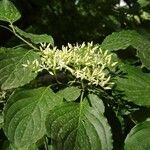Trees 3–13(–20) m tall. Bark dark gray or yellowish gray, smooth; branches ± horizontal; branches of current year purplish, later greenish, glabrous or pubescent; older branches greenish, with conspicuous semicircular leaf scars and rounded lenticels; winter buds purplish, ovoid or conical, 3–8 mm, glabrous, with several alternate overlapping scales. Leaf blade broadly ovate or broadly elliptic-ovate, 5–13 × 3–9 cm, abaxially light or grayish green, sparsely pubescent with appressed trichomes, papillate, veins 6 or 7(–9), abaxially raised and slightly purplish, base subrounded, apex acute or acuminate. Corymbose cymes terminal, 5–14 cm in diam., pubescent with appressed trichomes. Flowers 8–9 mm in diam.; buds nearly orbicular, shortly pedicellate. Calyx teeth ca. 0.5 mm, taller than disk. Petals oblong-lanceolate, 3–4.5 × 1–1.6 mm. Stamens longer than petals; filaments whitish, 4–5 mm. Style 2–3 mm, glabrous. Fruit purplish red or bluish black, globose, 6–7 mm in diam.; stones globose, 5–6 mm in diam., inconspicuously 8-ribbed. Fl. May–Jun, fr. Jul–Sep. 2n = 20.
More
A tree. It grows to 12 m tall. It has a straight trunk with branches in tiers. It loses its leaves during the year. The leaves are dark green. They turn purple in autumn. The leaves are glossy and strongly veined. They are arranged alternately on the red twigs. The flowers occur in flat clusters. They are white and about 10 cm across. The fruit are bluish-black. They are shiny.
It is a temperate plant. It is native to East Asia. It does best in light to medium, well-drained soils. It needs an open sunny position. It is resistant to frost but sensitive to drought. It suits hardiness zones 5-8. Burnie Rhodo garden. Arboretum Tasmania.
More
Woodland, hedges and thickets; at elevations from 600-2,000 metres. Broad-leaved or mixed broad-leaved and needle-leaved forests; at elevations from 200-2,600 metres.


